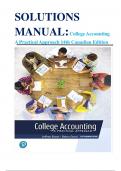SOLUTIONS
MANUAL: College Accounting
A Practical Approach 14th Canadian Edition
, INSTRUCTOR’S SOLUTIONS
MANUAL
Brenda Ridgeley-Ketchell
Okanagan College
College Accounting:
A Practical Approach
Fourteenth Canadian Edition
Jeffrey Slater
North Shore Community College
Debra Good
Conestoga College
ISBN: 978-0-13-543694-3
Copyright © 2021 Pearson Canada Inc., Toronto, Ontario. All rights reserved. This work is protected by Canadian copyright
laws and is provided solely for the use of instructors in teaching their courses and assessing student learning. Dissemination
or sale of any part of this work (including on the Internet) will destroy the integrity of the work and is not permitted. The
copyright holder grants permission to instructors who have adopted College Accounting by Slater and Good, to post this
material online only if the use of the website is restricted by access codes to students in the instructor’s class that is using the
textbook and provided the reproduced material bears this copyright notice.
© 2021 Pearson Canada All
Rights Reserved 4-1
,1
Accounting Concepts and
Procedures: An Introduction
ANSWERS TO DISCUSSION QUESTIONS AND
CRITICAL THINKING/ETHICAL CASE
1. The functions of accounting are to analyze, record, classify, summarize, report and interpret
information.
2. Sole proprietorship—one owner, unlimited liability; easy to form Partnership—two or more owners;
unlimited liability, easy to form Corporation—one or more shareholders; limited liability; more
difficult to form.
3. Service, merchandising, or manufacturing.
4. The objective of accounting is to provide relevant, timely information for user decision making.
Accountants must behave in an ethical manner so that the information they provide will be
trustworthy and, therefore, useful for all decisions. Ethics are moral principles that guide the conduct
of individuals. Sometimes business managers and accountants behave in an unethical manner.
5. The three elements of the basic accounting equation are assets, liabilities, owner’s equity.
6. Capital is the owner’s current investment or equity in the assets of a business. It is one subdivision of
owner’s equity.
7. True. The sum of the left side of the equation must equal the sum of the right side of the equation.
8. False. It is the income statement that tells how well the company has performed.
9. False. Revenue is a subdivision of owner’s equity.
10. Owner’s equity is subdivided into Capital, Withdrawals, Revenue, and Expenses.
11. False. It is a subdivision of owner’s equity.
12. Reject. As expenses increase and revenue remains the same, owner’s equity decreases.
13. Revenue less Expenses; an income statement shows performance—profit or loss for the period.
14. False. It calculates ending capital.
15. The question in this case is whether Paul should be allowed to ―pad‖ his expense account with an
additional $100 of expenses. Paul should be allowed to charge only those items that are business
related. Paul’s argument that he is entitled to an additional $100 is not a valid assumption. However,
he should be allocated money for any business expenses during the weekend. Paul should also ask his
employer for additional compensation for working during his non scheduled time. The important point
is that accountants need to be seen as being ethical and should not do unethical activities.
© 2021 Pearson Canada All
Rights Reserved 4-1
, SOLUTIONS TO CLASSROOM DEMONSTRATION EXERCISES
CDE1. a. A CDE4. $24,000 ($12,000 + $12,000) CDE8. a. IS
b. A b. BS
c. L CDE5. c. J. Penny, Capital c. BS
d. A d. Advertising Expense d. BS
e. OE f. Taxi Fees Earned e. IS
f. A g. J. Penny, Withdrawls f. IS
g. OE
h. BS
CDE2. a. Liabilities and or CDE6. c. Accounts Payable
b. Equities
Assets d. Grooming Fees Earned CDE9 a. OE
c. Accounts Payable b. BS
c. BS
d. IS
CDE3. a. I CDE7. a.
b. S b.
d.
CDE10.
1. Balance Sheet
2. Assets
3. Liabilities
4. Accounting Equation
5. Accounts Payable
6. Service
7. Owner’s Equity
8. Accounts Receivable
9. Transaction
10. Creditor
SOLUTIONS TO EXERCISES—SET A
E1-1A.
a. $15,000 ($19,000 − $4,000)
b. $15,000 ($ 6,000 + $9,000)
c. $ 6,000 ($10,000 − $4,000)
E1-2A.
1. Service 6. Service
2. Merchandise 7. Service
3. Service 8. Manufacturer
4. Merchandise 9. Manufacturer
5. Merchandise 10. Merchandise
E1-3A.
1-3A Solutions
1. B
2. B
3. B
4. A
5. D
6. D
© 2021 Pearson Canada All
Rights Reserved 4-1




